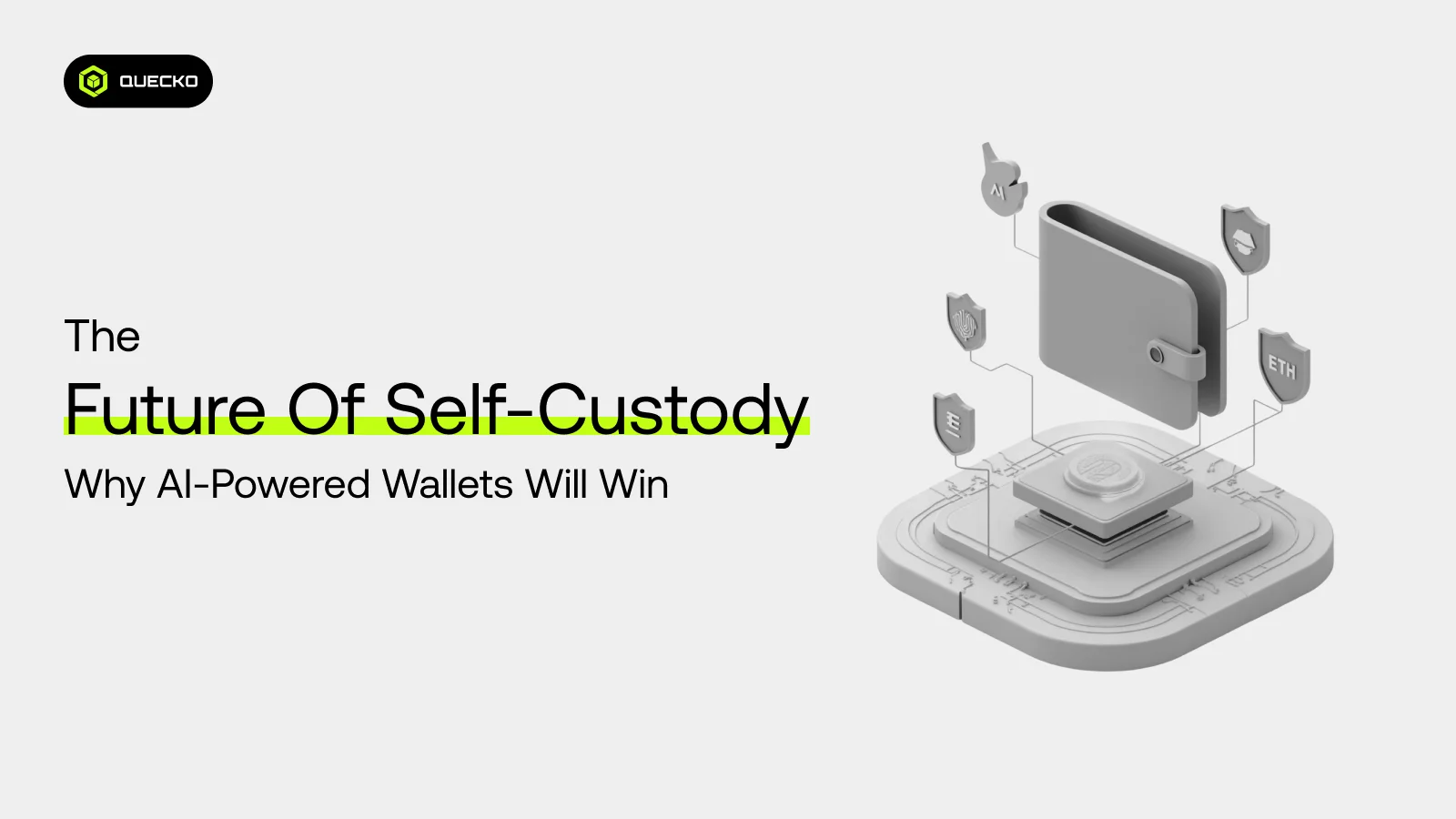The Future of Self-Custody: Why AI-Powered Wallets Will Win
Discover how AI-powered self-custody wallets are revolutionizing digital asset security and control. Explore the future of decentralized finance and why these innovative wallets will lead the way.

The landscape of digital asset management is rapidly evolving, driven by technological innovations and shifting user expectations. At the forefront of this transformation is the concept of self-custody; empowering individuals to maintain full control over their cryptocurrencies and digital assets without relying on third-party intermediaries. As traditional custodial solutions face increasing scrutiny over security breaches, regulatory challenges, and centralized vulnerabilities, the appeal of self-custody continues to grow. The rise of blockchain networks and smart contracts has facilitated more secure and automated asset management, further enabling decentralized finance (DeFi) platforms that eliminate intermediaries. Additionally, the development of decentralized identity solutions enhances user privacy and security, making self-custody more accessible. However, managing private keys and securing assets independently can be complex and intimidating for many users, creating a demand for smarter, more intuitive solutions that cater to institutional investors and individual users alike.
Enter AI-powered wallets: a groundbreaking fusion of artificial intelligence and digital asset management designed to enhance security, usability, and user experience. These intelligent wallets leverage advanced AI algorithms to provide real-time threat detection, personalized security recommendations, seamless recovery options, and smarter transaction management. By integrating AI, self-custody solutions can transcend the limitations of manual key management and offer users a more resilient, accessible, and trustworthy way to control their assets. Additionally, these wallets support the execution and management of Smart Contracts within various blockchain networks, facilitating complex decentralized operations. They are increasingly vital for institutional investors seeking secure and efficient access to DeFi platforms, and they incorporate decentralized identity features to enhance user privacy and control over personal data.
Looking ahead, the future of self-custody is poised to be shaped significantly by AI-powered wallets. As these technologies mature, they are expected to democratize access to secure self-custody, reduce the technical barriers for everyday users, and foster greater confidence in decentralized finance. In this context, AI-powered wallets are not just an evolution—they are a revolution that will redefine how individuals interact with, safeguard, and grow their digital assets in an increasingly decentralized world.
This transformation will also enhance the security and efficiency of managing assets through smart contracts and cold storage solutions, ensuring that transaction data remains protected. Moreover, regions like the Middle East are likely to see increased adoption of these innovative self-custody tools, further integrating AI-driven security measures into the broader DeFi platforms.
The Rise of Self-Custody in the Digital Age
In recent years, the concept of self-custody has gained significant momentum within the landscape of digital assets, fundamentally transforming the way individuals interact with and control their financial holdings. This shift is driven by technological innovation, evolving perceptions of security and privacy, and a growing desire for financial sovereignty. The integration of smart contracts and DeFi platforms has further empowered users by enabling more autonomous and transparent financial transactions. Additionally, developments such as Account Abstraction are enhancing user experience and security. Regions like the Middle East are increasingly adopting these technologies, while innovations in insurance policies related to digital assets are providing new layers of protection and trust in this evolving ecosystem.
Understanding Self-Custody
Self-custody refers to the practice of individuals maintaining direct control over their digital assets—such as cryptocurrencies—without relying on third-party intermediaries like centralized exchanges or custodial wallets. This approach empowers users to be their own bank, managing private keys and transaction authorization independently. With advancements like smart contracts and Account Abstraction, users can enhance security and functionality. The use of multi-signature wallets and smart contract wallets further strengthens custody solutions, allowing multiple approvals for transactions and automated management. In regions like the Middle East, where digital asset adoption is growing, self-custody offers a way to maintain sovereignty over assets. Additionally, digital assets can be integrated with insurance policies to provide security against potential losses, making self-custody a comprehensive approach to managing digital assets securely and autonomously.
Drivers Behind the Growth
Few drivers behind the growth are:
- Decentralization and Blockchain Technology: The foundational principles of blockchain; decentralization, transparency, and security have made self-custody increasingly feasible and appealing. Users recognize that owning private keys equates to ownership of assets, reducing reliance on centralized entities susceptible to hacking, insolvency, or censorship. Innovations such as smart contracts and smart contract wallets further enhance automation and security in managing digital assets. The Cosmos ecosystem and Inter-Blockchain Communication (IBC) enable seamless interoperability between different blockchains, fostering a more interconnected blockchain landscape. In regions like the Middle East, these advancements are gaining momentum, driving adoption and fostering new opportunities for decentralized applications and account abstraction solutions that simplify user experience and enhance security.
- Security and Privacy Concerns: High-profile security breaches in centralized exchanges have highlighted vulnerabilities associated with third-party custody. Self-custody offers enhanced control over assets, minimizing exposure to external threats and preserving user privacy. Technologies like smart contracts and smart contract wallets within the Cosmos ecosystem facilitate secure and transparent transactions. In regions like the Middle East, where evolving regulatory landscapes are emerging, Account Abstraction is gaining traction to improve user experience and security. Additionally, the rise of tokenized securities underscores the importance of robust security measures in decentralized finance, further emphasizing the value of self-custody solutions.
- Financial Sovereignty and Autonomy: A cultural shift towards individual empowerment in financial matters fuels interest in self-custody. Users seek to avoid intermediaries, reduce dependency, and participate directly in the digital economy. This trend is particularly evident with the adoption of smart contracts and smart contract wallets, which facilitate more secure and autonomous transactions. Regions like the Middle East, North America, and Eastern Europe are witnessing increased engagement with these innovations. Additionally, technological advancements such as Account Abstraction are simplifying user experiences, further promoting self-custody and decentralized control over digital assets.
- Regulatory and Geopolitical Factors: Changes in regulation, restrictions on certain financial services, or economic instability in particular regions—such as the Middle East, North America, or Eastern Europe—can motivate users to hold assets securely outside traditional financial systems. Innovations like account abstraction and smart contract wallets are increasingly utilized to enhance security and control. Additionally, fluctuations in the total value locked (TVL) across decentralized platforms may reflect shifting user preferences driven by geopolitical and regulatory developments.
Technological Innovations Facilitating Self-Custody
Few of the examples for technological innovations are:
Hardware Wallets: Devices such as Ledger and Trezor provide secure environments for private key storage, making self-custody more accessible and safer against online threats. In the Middle East, increasing adoption of hardware wallets is driven by the need for enhanced security amid growing cryptocurrency activity.
Software Wallets: Mobile and desktop wallets enable convenient management of assets while offering security features like encryption, multi-signature capabilities, and wallet integration with various platforms. The development of smart contract wallets further enhances user control and security, especially when combined with threshold signatures and prompt encryption techniques.
Decentralized Exchanges and Protocols: The emergence of decentralized finance (DeFi) platforms, including those built on networks like Aztec network, allows users to interact directly with assets, increasing the importance of self-custody for participating in lending, borrowing, and trading. These protocols emphasize the significance of self-custody solutions such as hardware wallets and smart contract wallets to ensure security and privacy.
Challenges and Considerations
While self-custody offers numerous benefits, including innovative solutions like “smart contract wallets” and “AI-agent wallets,” it also places responsibility on users to securely manage private keys and understand complex security practices such as “biometric access controls.” Proper “Wallet Integration” is essential to enhance security and usability. Loss of private keys results in irreversible loss of assets, underscoring the importance of education and robust security measures. This is especially relevant in regions like the “Middle East” and “Eastern Europe,” where expanding blockchain adoption highlights the need for secure and user-friendly self-custody options.
Impacts on the Financial Ecosystem
The rise of self-custody signals a paradigm shift towards a more democratized and resilient financial system, especially across regions like the Middle East and Eastern Europe. It encourages innovation in security solutions such as smart contract wallets, AI-agent wallets, and wallet integration, which enhance user control and security. By leveraging off-chain data sources and decentralized oracles, these solutions can facilitate more accurate and reliable transaction validation. Additionally, features like shielded transactions, anomaly detection, and time-locking keys provide further layers of security and privacy. Self-custody promotes financial literacy and fosters a culture of individual empowerment, challenging traditional financial institutions to adapt to a landscape where control over assets is increasingly decentralized.
In short, the ascent of self-custody in the digital age encapsulates a broader movement towards personal sovereignty, privacy, and security in financial dealings. As technological tools become more sophisticated and accessible—such as smart contract wallets and AI-agent wallets—self-custody is poised to play an increasingly central role in the future of digital finance. This evolution is evident across regions like North America, Eastern Europe, and the Middle East, reshaping how individuals perceive and exercise ownership over their assets.
Why AI-Powered Wallets Are Poised to Lead
In the rapidly evolving landscape of digital finance, artificial intelligence (AI) has emerged as a transformative force, particularly in the realm of digital wallets. AI-powered wallets are redefining how consumers and businesses manage, secure, and optimize their financial transactions across regions such as the Middle East, North America, and Eastern Europe. Several core reasons underpin their potential to lead the future of digital payments, including the development of innovative solutions like smart contract wallets and AI-agent wallets, which enhance automation, security, and user experience globally.
- Enhanced Security and Fraud Prevention
AI technologies in the Middle East excel at real-time data analysis and pattern recognition. AI-powered wallets, such as smart contract wallets and AI-agent wallets, utilize machine learning algorithms to detect suspicious activities and potential threats instantly. This proactive approach, enhanced by cloud models and federated learning, significantly reduces the risk of fraud, unauthorized access, and identity theft. The integration of anonymous credentials further strengthens privacy and security. Continuous learning models adapt to new fraud tactics, providing a dynamic defense mechanism that traditional security measures lack.
- Personalized User Experience
AI enables wallets to analyze user behavior, preferences, and transaction history to deliver highly personalized services. This can include tailored financial advice, customized notifications, and optimized spending suggestions. Personalization fosters greater user engagement and satisfaction, making digital wallets more intuitive and user-friendly. In the Middle East, AI-agent wallets integrated with the ChatGPT Plugin are increasingly popular. These advanced wallets often display essential details such as the List Price, Member Price, and Product Code to enhance the user experience and streamline transactions.
- Smarter Financial Management
AI-powered wallets, including those in the Middle East and Eastern Europe, often integrate budgeting tools, expense tracking, and predictive analytics. AI-agent wallets, enhanced by ChatGPT Plugin functionalities, can forecast future spending patterns, suggest cost-saving opportunities, and automate routine financial tasks. Such features empower users to make informed financial decisions, promoting better financial health and literacy.
- Seamless and Adaptive Payment Processes
AI enhances payment processes by enabling features like voice-activated transactions, biometric authentication, and frictionless checkout experiences. These advancements reduce transaction times and improve convenience, encouraging wider adoption among diverse user groups, including regions like Eastern Europe. Additionally, AI-agent wallets and ChatGPT Plugin integrations are further streamlining payment solutions, making transactions more secure and user-friendly worldwide.
- Advanced Data Insights and Decision-Making
By analyzing vast amounts of transaction data, AI-powered wallets, including AI-agent wallets, offer insights into spending habits, investment opportunities, and financial trends. This data-driven approach helps users in Eastern Europe optimize their finances and supports businesses in targeted marketing and personalized offers. Additionally, the integration of the ChatGPT Plugin enhances the user experience by providing more interactive and intelligent financial assistance.
- Integration with Emerging Technologies
AI wallets are increasingly integrating with other emerging technologies such as blockchain, IoT, and 5G. This synergy facilitates secure, transparent, and instantaneous transactions across various platforms, expanding the utility and reach of digital wallets. In Eastern Europe, the adoption of AI-agent wallets is gaining momentum, often leveraging ChatGPT plugins to enhance user experience and functionality.
- Scalability and Continuous Improvement
AI systems in Eastern Europe and North America are inherently scalable and capable of continuous learning. As user bases grow and data accumulates in these regions, these wallets become more intelligent, efficient, and versatile, ensuring they stay ahead in a competitive market.
In short, AI-powered wallets are set to lead because they combine security, personalization, efficiency, and intelligence in ways traditional wallets cannot match. Their ability to adapt, learn, and seamlessly integrate with other technological innovations positions them at the forefront of digital financial services.
Challenges and Considerations:
As artificial intelligence (AI) continues to reshape the financial technology landscape, AI-powered wallets are emerging as a transformative force in digital payments and personal finance management. These advanced digital wallets leverage AI to enhance user experience, security, and operational efficiency, positioning them to potentially lead the future of financial transactions across regions such as Eastern Europe and North America. However, several challenges and considerations must be addressed to realize their full potential.
Key Challenges
1. Data Privacy and Security Concerns
– AI-powered wallets rely heavily on vast amounts of personal and financial data to deliver personalized services. Ensuring the privacy and security of this sensitive information is paramount.
– Data breaches or misuse can erode user trust and lead to regulatory penalties, necessitating robust encryption, anonymization, and compliance with data protection laws like GDPR and CCPA.
2. Regulatory and Legal Uncertainty
– The evolving regulatory landscape surrounding AI and digital payments presents uncertainties. Different jurisdictions may have varying rules regarding data usage, transaction monitoring, and anti-money laundering (AML) measures.
– Navigating these regulations requires continuous adaptation and legal expertise to ensure compliance without hindering innovation.
3. Bias and Fairness in AI Algorithms
– AI models used in wallets for credit scoring, fraud detection, or personalized offers can inadvertently incorporate biases, leading to unfair treatment of certain user groups.
– Addressing algorithmic bias is critical to promote inclusivity and avoid potential legal and reputational risks.
4. Technical Complexity and Integration
– Developing sophisticated AI models and integrating them seamlessly into existing financial infrastructure involves significant technical challenges.
– Ensuring interoperability across various platforms, devices, and payment systems is essential for widespread adoption.
5. User Trust and Adoption
– Despite technological advancements, some users may remain skeptical of AI-driven decision-making, especially concerning security and privacy.
– Building trust through transparency, clear communication, and user education is vital for encouraging widespread adoption.
6. Cost and Resource Intensive Development
– Building and maintaining AI-powered wallets require substantial investment in infrastructure, data scientists, and ongoing updates.
– Smaller players may face barriers to entry, potentially leading to market consolidation where only large firms can compete effectively.
7. Dependence on Accurate Data and AI Performance
– The effectiveness of AI models depends on high-quality, accurate data. Poor data quality can lead to incorrect predictions, transaction errors, or fraud detection failures.
– Continuous monitoring and validation of AI performance is necessary to maintain reliability.
Considerations for Leading the Market
– Innovative Personalization
– AI enables highly personalized financial experiences, tailored offers, and proactive financial management, creating a competitive edge.
– Enhanced Security Measures
– Features like biometric authentication, real-time fraud detection, and adaptive risk assessment can significantly reduce fraud and enhance user confidence.
– Operational Efficiency
– Automating routine processes and leveraging predictive analytics can reduce costs and improve transaction speed.
– Regulatory Compliance and Ethical AI
– Developing transparent, explainable AI models and adhering to evolving regulations will be critical to sustain leadership.
– User-Centric Design
– Prioritizing user experience, simplicity, and trust-building strategies will encourage long-term engagement.
In short, while AI-powered wallets hold immense promise due to their potential for personalization, security, and efficiency, overcoming challenges related to data privacy, regulatory compliance, algorithmic bias, and technical complexity is essential. Addressing these considerations thoughtfully will position AI-powered wallets to lead the next era of digital finance, especially as adoption expands across regions like Eastern Europe and North America.
The Road Ahead
The landscape of digital asset management is rapidly transforming, with self-custody emerging as a pivotal component in empowering individuals to control their finances securely and independently across regions such as Eastern Europe and North America. As the cryptocurrency and decentralized finance (DeFi) sectors evolve, the future of self-custody hinges on integrating advanced technologies—most notably artificial intelligence (AI)—to create smarter, more secure, and user-friendly wallets.
The Rise of Self-Custody
Self-custody refers to users maintaining direct control over their private keys and digital assets, eliminating reliance on third-party custodians such as exchanges or custodial wallets. This approach enhances privacy, reduces counterparty risk, and aligns with the ethos of decentralization. However, it also introduces challenges like key management complexity, security vulnerabilities, and user onboarding hurdles.
The Limitations of Traditional Wallets
Conventional self-custody wallets—hardware wallets, seed phrases, multi-signature wallets—have made significant strides in security. Yet, they often require technical expertise, meticulous backup procedures, and vigilance against phishing or malware attacks. These barriers can deter mainstream adoption and increase the risk of asset loss due to human error.
Enter AI-Powered Wallets
Artificial intelligence promises to revolutionize self-custody by addressing these pain points through innovative features:
– Enhanced Security:
AI algorithms can detect suspicious activity patterns, identify potential phishing attempts, and even predict vulnerabilities before they manifest. Adaptive threat detection enables wallets to respond dynamically to emerging risks.
– Intelligent Key Management:
AI-driven systems can assist users in securely managing private keys, offering features like biometric authentication, context-aware access controls, and automated backup protocols, reducing human error.
– Personalized User Experience:
AI can analyze user behavior to tailor interfaces, streamline transaction processes, and provide proactive alerts or financial insights, making self-custody more accessible to non-technical users.
– Automated Recovery Solutions:
In case of lost keys or compromised devices, AI can facilitate secure recovery pathways, such as social recovery mechanisms or biometric re-authentication, safeguarding assets without compromising security.
Why AI-Powered Wallets Will Win
– Security and Trust:
The integration of AI enhances trust by proactively mitigating risks, reducing incidents of theft or loss, and providing users with a sense of control coupled with safety.
– User Adoption:
Simplified interfaces and intelligent assistance lower barriers for newcomers, accelerating mainstream adoption of self-custody solutions.
– Ecosystem Integration:
AI can enable seamless interoperability with decentralized applications (dApps), exchanges, and other financial tools, creating a cohesive user experience.
– Future-Proofing:
As threats evolve and user expectations grow, AI’s adaptability ensures wallets remain resilient and relevant in the dynamic blockchain environment.
Challenges and Considerations
Despite its promise, deploying AI in self-custody wallets entails challenges such as ensuring transparency, avoiding biases in AI decision-making, and maintaining user privacy. Developers must prioritize security audits, open standards, and user education to foster trust and widespread adoption. This is especially true in regions like Eastern Europe and North America, where regulatory landscapes and user expectations vary significantly.
In short, the future of self-custody is undeniably intertwined with AI innovation. AI-powered wallets are poised to deliver the perfect blend of security, simplicity, and intelligence, making self-custody not just a secure choice but the preferred one for a broader audience. As these technologies mature, they will play a crucial role in empowering individuals worldwide—particularly in diverse regions such as Eastern Europe and North America—to take full control of their digital assets, heralding a new era of decentralized financial sovereignty.
Conclusion
In conclusion, the future of self-custody is poised for a transformative evolution driven by the integration of AI-powered wallets. As the digital asset landscape becomes increasingly complex and security concerns mount, AI-enabled solutions offer a compelling blend of enhanced security, user-centric design, and intelligent automation that can democratize access to self-custody. These wallets will empower users with real-time risk assessment, personalized security protocols, and seamless management of their assets, reducing the reliance on third-party custodians and fostering greater financial sovereignty. Moreover, AI’s capacity for continuous learning and adaptive security measures will proactively identify and mitigate threats, making self-custody safer than ever before. As adoption accelerates, AI-powered wallets are likely to become the standard for individual asset management, bridging the gap between sophisticated security and user accessibility. Ultimately, their rise signifies a pivotal shift towards more autonomous, secure, and user-empowered digital asset ecosystems, ensuring that self-custody remains resilient, scalable, and aligned with the evolving needs of a decentralized future.
Date
23 days agoShare on
Related Blogs

No-Code Smart Contract Builders: How UI/UX is Democratizing Blockchain Development
2 days ago

The Role of Localization in Onboarding Non-Crypto Natives
8 days ago

The Role of AI in Detecting Smart Contract Vulnerabilities Before Deployment
11 days ago

How AI & Smart Contracts Create Personalized User Experiences
16 days ago







